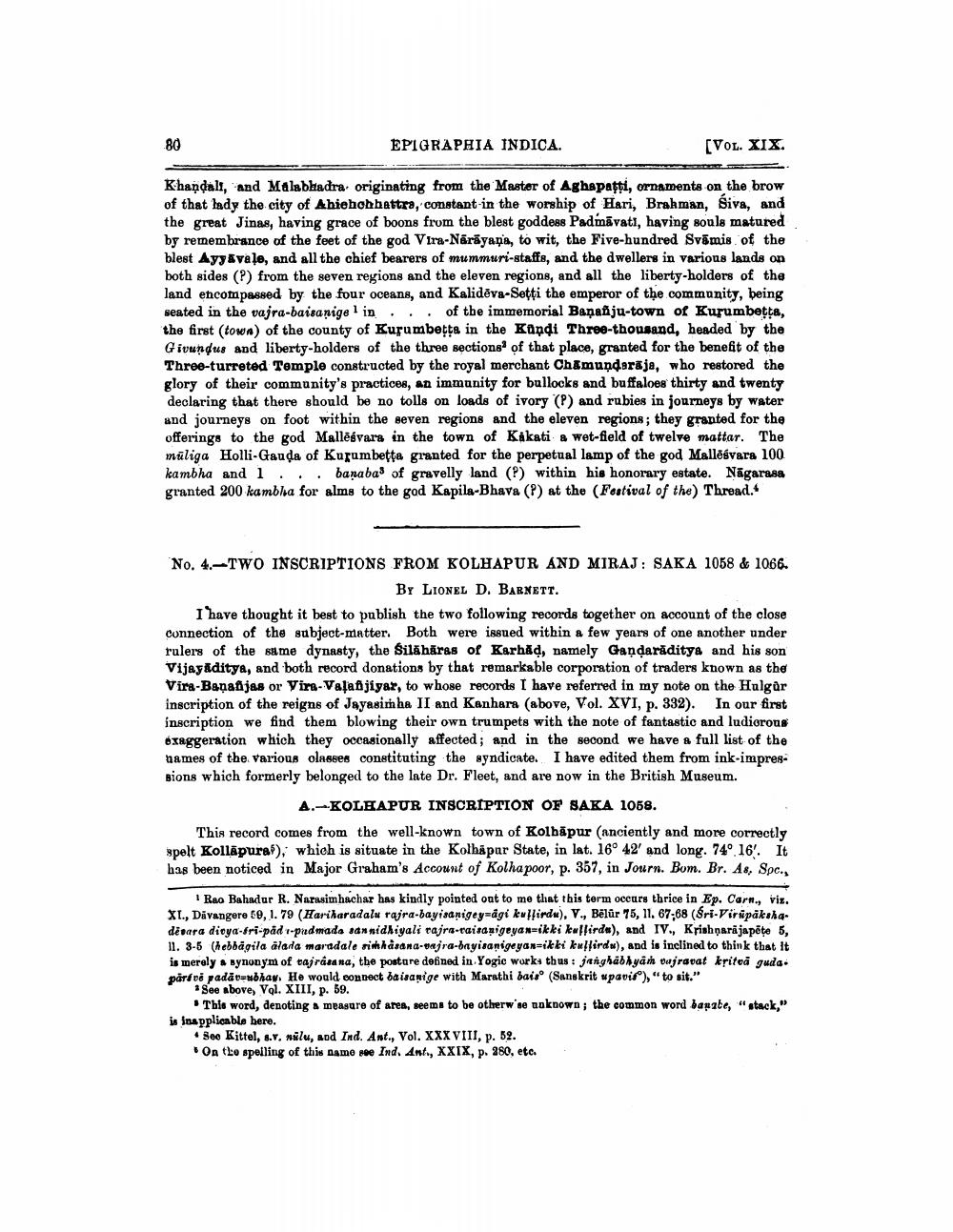________________
EPIGRAPHIA INDICA.
(VOL. XIX.
Khandall, and Malabhadra originating from the Master of Aghapatti, ornaments on the brow of that lady the city of Ahiehohhattra, constant-in the worship of Hari, Brahman, Siva, and the great Jinas, having grace of boons from the blest goddess Padmāvatı, having souls matured by remembrance of the feet of the god Vira-Nārāyana, to wit, the Five-hundred Svāmis of the blest Ayyavalo, and all the chief bearers of mummuri-staffs, and the dwellers in various lands on both sides (?) from the seven regions and the eleven regions, and all the liberty-holders of the land encompassed by the four oceans, and Kalidėva-Seçți the emperor of the community, being seated in the vajra-baisanigel in... of the immemorial Banazju-town of Kurumbetta, the first town) of the county of Kurumbetta in the Kündi Three-thousand, headed by the Givundus and liberty-holders of the three sections of that place, granted for the benefit of the Three-turreted Temple constructed by the royal merchant Chamundaraja, who restored the glory of their community's practices, an immunity for bullocks and buffaloes thirty and twenty declaring that there should be no tolls on loads of ivory () and rubies in journeys by water and journeys on foot within the seven regions and the eleven regions; they granted for the offerings to the god Mallēsvara in the town of Kikati & wet-field of twelve mattar. The mūliga Holli-Gauda of Kufumbetta granted for the perpetual lamp of the god Mallēsvara 100 kambha and 1 ... banabas of gravelly land (?) within his honorary estate. Nāgarasa granted 200 kambha for alms to the god Kapila-Bhava (?) at the (Festival of the) Thread.
No. 4.-TWO INSCRIPTIONS FROM KOLHAPUR AND MIRAJ: SAKA 1058 & 1066.
Be LIONEL D. BARNETT. I have thought it best to publish the two following records together on account of the close Connection of the subject matter. Both were issued within a few years of one another under rulers of the same dynasty, the Silăbāras of Karhăd, namely Gandarāditya and his son Vijayāditya, and both record donations by that remarkable corporation of traders known as the Vira-Baņafijas or Vira-Vaļafijiyar, to whose records I have referred in my note on the Hulgar inscription of the reigns of Jayasimha II and Kanhara (above, Vol. XVI, p. 332). In our first inscription we find them blowing their own trumpets with the note of fantastic and ludicrous exaggeration which they occasionally affected; and in the second we have a full list of the names of the various olasses constituting the syndicate. I have edited them from ink-impresBions which formerly belonged to the late Dr. Fleet, and are now in the British Museum.
A.-KOLEAPUR INSCRIPTION OF SAKA 1058. This record comes from the well-known town of Kolbāpur (anciently and more correctly spelt Kollāpura), which is situate in the Kolhapar State, in lat. 16° 42' and long. 74° 16'. It has been noticed in Major Graham's Account of Kolhapoor, p. 357, in Journ. Bom. Br. As. Spc.,
Rao Bahadur R. Narasimhachar has kindly pointed oat to me that this term occurs thrice in Ep. Carn., viz. XL., Davangere 50, 1. 79 (Hariharadalu rajra-bayisanigey=agi kuļsirds), V., Bēlür 75, 11. 67-68 (Sri-Virupakshaderara divya Sri-påd -pud mada sannidhiyali raja-raisanigeyan ikki kulfirde), and IV., Krishparajapote 5, 11. 3-5 (hebbágila alada maradale sinhasana-oajra-bayisanigeyan-ikki kulfirds), and is inclined to think that it is merely - synonym of tajrasana, the postare defined in Yogic work, thus: janghábhyah wujravat kritua guda. pårivi padav=wbhay. He would connect baisanige with Marathi baiso (Sanskrit apavir), "to sit."
* See above, Vol. XIII, p. 59.
This word, denoting a measure of area, seems to be otherw'se anknown; the common word barabe, "stack," is inapplicable here.
• See Kittel, s.v. nulu, aod Ind. Ant., Vol. XXXVIII, p. 52. On the spelling of this name see Ind. Ant., XXIX, p. 280, etc




